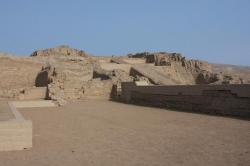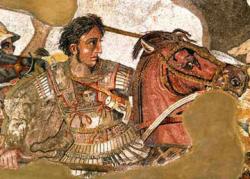INSTITUT SUPERIEUR D'ANTHROPOLOGIE
INSTITUTE OF ANTHROPOLOGY
ONLINE COURSES / COURS A DISTANCE
OPEN COURSE : APRIL 2013
HRM 104 : INTRODUCTION TO INTANGIBLE CULTURAL HERITAGE
REGISTER NOW
PEROU –  Tupac Amaru A/B - A Ministry of Culture team on Tuesday unveiled 11 pre-Inca tombs located inside Peru’s National Sports Village, where excavation work began last December. The structures are relics of the Lima and Yschma cultures, which flourished during the periods A.D. 200-700 and 1100-1400, respectively. The director of the project to excavate the Tupac Amaru A and B archaeological sites, Fernando Herrera, in presenting the work done so far said that the importance of the graves is that they were found intact, despite the fact that about 50 percent of the monument was lost during nearby modern construction activities. “What we can see is what has been saved from centuries of reductions, looting and, in general, urban expansion that has been reducing and eliminating the great majority of the tombs that were there in the three valleys in the current Lima Metropolitan area,” Deputy Culture Minister Rafael Varon said. The site includes an adobe base and has rooms that contain mummified bodies along with offerings of ceramics and seeds. The location served as an administrative center for the Lima culture and afterwards became a ritual zone for the Yschma, Herrera said. Scientists have not yet been able to determine either the sex or the age of the mummified individuals.
Tupac Amaru A/B - A Ministry of Culture team on Tuesday unveiled 11 pre-Inca tombs located inside Peru’s National Sports Village, where excavation work began last December. The structures are relics of the Lima and Yschma cultures, which flourished during the periods A.D. 200-700 and 1100-1400, respectively. The director of the project to excavate the Tupac Amaru A and B archaeological sites, Fernando Herrera, in presenting the work done so far said that the importance of the graves is that they were found intact, despite the fact that about 50 percent of the monument was lost during nearby modern construction activities. “What we can see is what has been saved from centuries of reductions, looting and, in general, urban expansion that has been reducing and eliminating the great majority of the tombs that were there in the three valleys in the current Lima Metropolitan area,” Deputy Culture Minister Rafael Varon said. The site includes an adobe base and has rooms that contain mummified bodies along with offerings of ceramics and seeds. The location served as an administrative center for the Lima culture and afterwards became a ritual zone for the Yschma, Herrera said. Scientists have not yet been able to determine either the sex or the age of the mummified individuals.
http://www.hispanicallyspeakingnews.com/latino-daily-news/details/11-pre-inca-tombs-from-lima-and-yschma-cultures-found-in-peru/22520/
TURQUIE – Taksim - Excavations continuing as part of the project to pedestrianize Taksim have revealed two water outlets 80 centimeters in diameter from the late Ottoman period, halting work in the area. “First observations have shown that there are two possibilities. This water outlet might be of the Taksim Military Barracks. Or it may be a water outlet of Maksem, which provided water to Istanbul 40-50 years ago. The Protection Committee reporters came to the area with us and kept reports. According to the decision of the committee, the Archaeology Museums will continue working. This finding does not prevent the general work in Taksim. We will do our best to accelerate the process for a decision,” Bilgili said. Noting that the water outlets were from the late Ottoman period between 1800 and 1900, he added, “Work has been locally halted at the moment but other work continues.
http://www.hurriyetdailynews.com/taksim-excavations-reveal-historic-ottoman-structures.aspx?pageID=238&nID=41995&NewsCatID=375
CHINE – Xi’an - A public cemetery uncovered in the city of Xi'an, capital of Northwest China's Shaanxi province, was used for maids of the Tang Dynasty (618 - 907), an archaeologist told Xinhua Tuesday. A dozen tombs, located in the west of the thousands-year-old city, were found in April, 2012, Liu Daiyun, a Shaanxi Archeology Research Institute researcher said. Since then, the tombs have been examined. "The structures of the tombs in this region are similar, and they have obvious characters of the Tang Dynasty. According to the epitaph of a 70-year-old maid, we deduced that the place was a public cemetery for maids of the imperial palace," Liu said. Archaeological data showed the maids were buried individually. Archaeologists said that the epitaphs of each maid showed a specific and strict hierarchy in the imperial palace. "There are two types of maids according to the epitaphs. Five of them died of old age, and the rest were "Wanggongni" -- maids who became nuns because the emperor they served died before them," Liu said. Archaeologists also excavated a variety of funerary objects in the tombs, including lacquer, bronze, stone wares, animal figures and bronze waistbands. "The discovery provides significant objects and literal materials for those researching the political system, lives, funeral customs and women in the palace of Tang Dynasty," Liu added.
http://europe.chinadaily.com.cn/china/2013-02/26/content_16257963.htm
GRECE –  Thessalonique - Thessaloniki plans to “revive” the life, work and historical battles of Alexander the Great, by creating a theme park. “Alexanderland”, as the park is dubbed, aims to promote the tourist and cultural development of Thessaloniki, as the deputy governor of Central Macedonia, Giorgos Tsamaslis, said. The ambitious project will use Disneyland as a model. It will include interactive displays, simulated battles, audiovisual presentations and exhibitions. The park is estimated to encompass 300 acres. Officials are already discussing three state owned plots which could be used for Alexanderland. Tsamaslis’s office is also consulting with experts at Thessaloniki’s Aristotle University in order to draft a comprehensive proposal. At the same time, Tsamaslis’s office plans three extensive reformations for the creation of metropolitan parks in the city’s center, such as the National Park of Koroneia and Volvi lakes.
Thessalonique - Thessaloniki plans to “revive” the life, work and historical battles of Alexander the Great, by creating a theme park. “Alexanderland”, as the park is dubbed, aims to promote the tourist and cultural development of Thessaloniki, as the deputy governor of Central Macedonia, Giorgos Tsamaslis, said. The ambitious project will use Disneyland as a model. It will include interactive displays, simulated battles, audiovisual presentations and exhibitions. The park is estimated to encompass 300 acres. Officials are already discussing three state owned plots which could be used for Alexanderland. Tsamaslis’s office is also consulting with experts at Thessaloniki’s Aristotle University in order to draft a comprehensive proposal. At the same time, Tsamaslis’s office plans three extensive reformations for the creation of metropolitan parks in the city’s center, such as the National Park of Koroneia and Volvi lakes.
http://www.archaiologia.gr/en/blog/2013/02/28/alexanderland%E2%80%A6-as-disneyland/